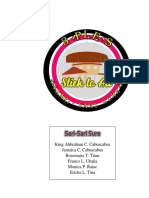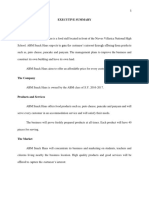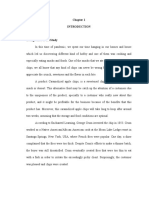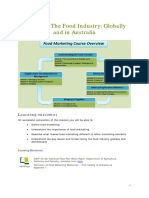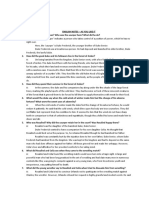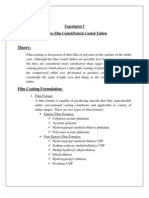Marketing Perishable Products: Logistics, Distribution, and Cold Storage
Marketing Perishable Products: Logistics, Distribution, and Cold Storage
Uploaded by
Jackcity OfwounderCopyright:
Available Formats
Marketing Perishable Products: Logistics, Distribution, and Cold Storage
Marketing Perishable Products: Logistics, Distribution, and Cold Storage
Uploaded by
Jackcity OfwounderOriginal Title
Copyright
Available Formats
Share this document
Did you find this document useful?
Is this content inappropriate?
Copyright:
Available Formats
Marketing Perishable Products: Logistics, Distribution, and Cold Storage
Marketing Perishable Products: Logistics, Distribution, and Cold Storage
Uploaded by
Jackcity OfwounderCopyright:
Available Formats
MARKETING PERISHABLE PRODUCTS: LOGISTICS, DISTRIBUTION, AND COLD STORAGE Quentin S.W.
Fonga, Sunny Riceb, and Brian Paustc
a
Alaska Marine Advisory Program
University of Alaska Fairbanks 118 Trident Way Kodiak Alaska 99615 T 907-486-1516 F 907-486-1504 E qfong@sfos.uaf.edu
b c
Sunny Rice
Brian Paust
Alaska Marine Advisory Program University of Alaska Fairbanks P.O. Box 1329 219 North Nordic Drive Petersburg, Alaska 99833 T 907-772-3381 F 907-772-4431 E fnar@uaf.edu (Sunny) E ffbcp@uaf.edu (Brian)
Introduction: What is marketing? Our colleagues in previous sessions, particularly those on business planning and conducting feasibility analyses, have emphasized the need to not only understand the markets and customers that a cold storage facility would serve, but also understand the markets that the customers of the cold storage facility are attempting to serve. This exercise takes the point of view of a direct
marketer of perishable products and examines his decision-making process regarding marketing, with emphasis on marketing channel selection and logistics.
So what is marketing? Marketing, according to the famous business writer Peter Drucker, is the whole business seen from the point of view of the final result, that is, from the customers point of view.Business success is not determined by the producer, but by the customer.
What this means is that, in addition to producing a product that a customer would want to buy, business people must ensure that all functions of their operation, including invoicing, logistics, service, credit policy, and even the use of language and tone of voice, must be customer friendly. In other words, all aspects of ones business are looked upon as a total product package that creates benefits or value to the customer. It is the customers valuation of alternative benefits from different products, say a farmed salmon fillet versus a wild harvested Alaskan salmon fillet, that determines his or her final purchase decision.
How do we know what benefits a company should provide in order to achieve its business objectives? This requires market research, whether done in-house or utilizing outside expertise, to elicit the preference structure or profile of existing and/or potential customers. The preference structure of a consumer is the net benefit that he or she would expect to gain from purchasing and using a product. A consumer will conduct trade-off calculations of the benefits and costs of competing products and choose the product that would give the greatest benefits. Figure 1
illustrates some of the benefit and cost categories that consumers may consider in determining the net benefit of a particular product.
An example of net benefits associated with a seafood purchase
Lets assume that a dinner is being planned by John and Jane Fisher, who reside in Manhattan, New York City, for Janes parents. When asked what they would like to be served, the parents requested seafood. This helps Jane, who is the primary grocery shopper, narrow down her choices from among the more than 15,000 items available in a typical super market. Still, with a given budget, Jane must choose from among many choices presented at the seafood counter jumbo farm-raised black tiger prawns from Thailand, large trawl-caught shrimp from South Carolina, live Maine lobster, farmed-raised Scottish salmon, Alaskan troll-caught King salmon, etc. To get the most benefit, value, or satisfaction out of the seafood item soon to be purchased, Jane weighs the pluses (benefits) and minuses (costs) that each item would generate for the meal. Let us also assume that Jane is intrigued by the Alaskan troll-caught King salmon, since she, John, and the two kids have not had Alaskan salmon before, but have seen many nature documentaries about Alaska. Utilizing the benefit and cost categories presented in Figure 1, Jane
first considers the benefits that the product itself produces. By chatting with the salesperson at the seafood counter, Jane finds out that the Alaskan salmon is fresh and natural - no artificial additives are added. Further, the skin is unblemished, with no scale loss, and the fillets sold are without pin bones, a benefit since the Fishers have two young children. In the course of dealing with the personnel from the seafood counter, Jane thinks that the help and recommendations that she is getting are superb. Tom, the seafood counter clerk, is professional, yet friendly with a great sense of humor. Moreover, he is knowledgeable about the products the store carries and is willing to further process the product by taking the skin off of the fillet, since Janes kids cannot bear the sight of fish skin on their plates.
Aside from the product, service, and personnel benefits that Jane is considering, she may also consider the image that she portrays to her parents. This dinner holds special significance since it is Janes parents 50th wedding anniversary and they have made a special trip to New York from Kansas to celebrate. Thus, Jane wants to serve something special and out of the ordinary. Jane sees Chilean sea bass, Australian crawfish tail, and Alaskan King salmon as the most prestigious seafood items.
While Jane determines the benefits she would derive from buying a certain product, she also considers the costs of the seafood items that she may end up bringing home. Monetary cost is an important attribute that Jane may consider. For example, while a previously frozen tilapia fillet may cost $5.99/lb., the Chilean sea bass, Australian crawfish tail, and Alaskan king salmon may cost $12.99, $18.99, and $14.99 per pound respectively. Another non-monetary cost that Jane might consider is the length of time to prepare the meal, since the family may decide to go to Central Park or a museum on the day of the dinner. Another concern is the energy required to prepare the meal. For example, if Jane decided to make baked stuff shrimp, she would have to peel the shrimp and make the stuffing, while at the same time baking the pie, entertaining the parents, and making sure that the children are taken care of. This may require a lot of work and energy. Further, what would happen if the rest of the family did not like the seafood chosen for the main course? This could impose such a great psychic cost or embarrassment to Jane that she would never serve the same seafood item again.
Luckily, the Fisher family has a great tradition of being adventurous with new food items, and enjoys cooking together and trying out new recipes. Rather than spending the day of the meal out, the entire family elected to stay home to prepare dinner together. After weighing all the benefits and costs that each item yields, the final dinner menu was as follows: Penn Cove oysters on the half-shell from Washington State for an appetizer; bouillabaisse with Alaskan halibut, Australian crawfish tail, and Maine mussels as the soup course; a green salad; Alaskan troll-caught King salmon with mango-pineapple salsa, accompanied with wild rice and mushroom pilaf and steamed mixed greens as a main course; and apple pie a la mode for dessert.
Market Mix - creating and managing customer benefits
Once the target market segment is identified, a marketing management program should be planned, designed, and implemented to satisfy the needs and wants of the customers within the particular segment. There are four major tools that one can use in the process of creating customer benefits. Collectively known as the marketing mix, these are (Figure 2): product price placement promotion Since we are focusing on matters that pertain to logistical and distributional issues (placement) from a perishable product marketers point of view, only a brief description of the remaining marketing mixes is presented here.
Product - product features
One of the most important tools of the marketing mix is product. Product features have to be designed to suit the taste and preferences of target customers. For example, Tom, a catcher/processor of salmon in Alaska has found a customer segment - a small grocery chain that
would like to stock a frozen salmon fillet that is natural, pin-bone out, skin-on with minimal scale loss, 6 oz. portion, vacuum-sealed, etc. In order to be even considered and selected as a supplier, Tom has to demonstrate that he can produce the salmon product with minimal variance to the product specifications determined by the potential customer.
Promotion - the art of effective communications
Another tool that Tom will use is promotion. Promotion includes all the activities Tom will undertake to communicate to his customers. These include training salespeople and setting up communication and promotion programs such as advertising, sales promotion, public relations, and online marketing. For example, Tom starts supplying a small family-owned grocery chain somewhere in the midwestern United States with the frozen salmon fillet product previously mentioned. The grocery chain sells 2,500 lbs. of Toms supply within the first month and are interested in more for the next season.
The buyer asks for marketing support in the form of promotional materials and a publicity campaign to advertise Toms product. Tom is at first overjoyed to be asked by a buyer to
participate in a marketing campaign. When Tom starts to calculate the cost, including money, time, and energy required, however, he starts to have some doubts. This is because the monetary costs for the marketing support will have to be paid by Tom. This includes all promotional materials, sample products, personal expenses that Tom will incur for the publicity campaign, and all logistical costs including shipment of samples, and rental of equipment, tables and chairs etc. However, if this marketing program succeeds, Toms market will be greatly expanded, and the probability of repeated orders from the grocery chain will increase substantially. After reviewing his business objectives and plan, and the benefits/costs of success/failure of this marketing program, Tom elects to compromise. He chooses to engage in the marketing campaign using redesigned promotion materials and to postpone the more expensive publicity campaign for another season.
Price - review of calculations
Price is the monetary amount that the customer pays. It is also the only marketing-mix tool that generates revenue. Other marketing tools incur costs to the producer. When utilizing this tool to generate revenue, a perishable product producer such as Tom has to set prices at the wholesale/retail level, as well as setting discounts, allowances, and credit terms. Moreover, Toms product prices have to be commensurate with customers perceived benefits, or else the customer will turn to other products. For example, the Fisher family from our previous example may elect to buy fresh king salmon for future dinners, since they got rave reviews from Janes parents on their troll-caught king salmon with mango-pineapple salsa. They will purchase it even if the price for fresh Alaskan king salmon is up to six dollars per pound higher than for farmedraised salmon. This willingness to pay a higher price for Alaska salmon can be attributed to the fact that the net benefits the Fishers receive for each dollar paid for the king salmon is higher than for all other products, including farm-raised salmon. In order for Tom to ask for the price that will generate profit, he has to consistently deliver a product that customers believe is worth the price they pay for it.
Placement - distribution system design and management Another marketing mix tool that a perishable product producer must consider is placement or distribution. Since the topic of this conference is cold storage development, which is an essential component of the distribution or marketing chain for perishable products, the remaining part of our discussion concerns product distribution, marketing channel design, and channel management.
Review of the food system
Figure 3 gives an overall view of the food system. The food system is composed of different components, from harvesting/growing to processing, distributing, retailing, and finally consuming. The food system has many names attached to it: marketing channel, distribution
channel/chain, supply chain, demand chain, value-adding chain etc., depending on who one talks to. This authors here favors the use of value-adding chain, since all participants in the food system are engaging in value/benefit adding activities to satisfy the consumers needs and wants. The structure of the food system has undergone dramatic changes in the past few decades. First, the system has evolved from a need-based system to a want-based system. Foods are produced not only to satisfy mankind's physiological needs for vitamins, minerals, protein, lipids, and
carbohydrates, but also to satisfy the demand for variety and consistent quality of food products. This development stems from the increase in disposable income which began in the developing nations in the late 1950s, followed by many developing nations later. Due to this increasing demand for choice and value per dollar paid, the food system has been transitioning from an open market system to a managed system.
Contract farming is an example of a managed or administered system. Keep in mind that an open market system implies many independent companies in the marketing channel competing against each other, either horizontally or vertically. Horizontal competition refers to business concerns from the same value-added channel level competing amongst each other. For example, retailers that carry natural seafood products compete against each other for the same market segment. Vertical competition refers to members of different levels of the value-added chain competing against each other for profits. For example, a seafood processor may try to reduce the price paid to farmers and harvesters to increase their profit while farmers and harvesters would try to go to alternate buyers to increase their profit margins. Managed or administered channel refers to common ownership (vertical integration) and contractual arrangements. Since the modern day food business has become consumer driven, the value-adding leaders or "chain leaders" are usually the retailers or food service operators, that is, the business entities that are closest and thus most knowledgeable about the consumers. Due to their proximity and knowledge of the markets, chain leaders usually set the price, specifications for the products, and logistical requirements to the rest of the value-adding chain. For example, as in the case of the broiler (chicken) industry, Tom may encounter a potential customer that requires a contract that guarantees multi-year delivery of products with specified volume, product form, quality, mode of delivery, and price.
Focus on the value-adding segment of the food system
Given the highly competitive and consumer driven nature of the food system, all members of the value-adding chain are looking for innovative ways to increase returns to their operations. Alaska is no exception. A few recent developments include the following: the formation of harvesting cooperatives to provide for higher quality product (e.g. Chignik Cooperative); individual fisherman (e.g. direct marketers) forward integrating into the value-adding chain to locate their own market segments; processors producing value-added products such as smoked seafood; and regional (e.g. Kodiak salmon) and state-wide (Alaskan seafood) product differentiation and product "branding" initiatives. Whatever value-adding activities one has chosen, he or she must consider what their customer demands in terms of product distributional requirements.
Figure 4 shows some of the current trends in customer distributional requirements. One of these requirements is one-stop shopping. Retailers and restaurants must focus on their customers something that is more complicated than might be imagined. A lengthy list of organizational responsibilities is involved. For instance, a restaurant owner/chef is responsible for menu development, planning, and organization, kitchen staff management and training, maintenance of equipment, accounting, and the sourcing of food ingredients. Further, the owner/chef may also have the responsibilities of managing the waiters, building maintenance, and promotion, while at the same time maintaining his/her customer base. Due to the complex nature of the restaurants focus on its base its customers, it is not surprising that the restaurant buyer might find it necessary to streamline the purchasing process. For seafood items on the menu, instead of buying shrimp from one supplier, halibut from another, and salmon from yet another, the
restaurant will most likely buy from one distributor . Channel members, such as individual harvesters, who would like to forward integrate into the level where they could market their products to institutional restaurants or to the consumer level may have to think about eventually
providing an assortment of products to supply their intended market segment. Another option is to partner with a distributor and/or other members of the value-added chain to provide the product mix necessary to penetrate the intended market segment.
Other distributional requirements are on-time delivery, the suppliers willingness to carry inventory, quickness in re-supply, and the suppliers willingness to meet emergency needs. These demands by customers stem from the fact that many retailers and restaurant institutional buyers are unwilling to keep high levels of inventory to reduce the risk of products not being sold. Further, many of the retail operations are reducing fixed costs (e.g. rent/square feet) and variable costs (e.g. personnel for the stock room) by reducing/limiting storage spaces on their business premises. The trend towards just-in-time delivery places the responsibility of valueadded channel management on producers and distributors.
Recall that Tom, the catcher/processor, has started to market products into the mid-western United States and had sold 1,500 pounds of fillets the first year. After conducting further market research, he feels that he has identified a fairly large market segment for high quality natural
seafood products that has not yet been served by seafood producers. This market consists of three cities and their associated suburbs in two Midwestern states. Suppose that Tom, through his market research, has identified the product(s), pricing mechanisms, and communication tools that would help him become successful in the identified market. Now Tom has to decide on the courses of action as presented in Figure 5.
Although Tom has identified his potential consumers as middle-upper and upper income college educated professionals who frequent white table-cloth restaurants, and shop for natural food products, Tom has to consider several items when using placement (distribution) as part of his marketing mix. First, Tom has to decide on the channel in which he would like to place his products. This means that Tom has to decide whether he would like to concentrate on harvesting, processing, and sourcing other products from Alaska (leaving the selling and distributing to other business entities), or forward integrate himself into the value-adding chain by conducting sales and distribution himself. The advantage of the former is that Tom can concentrate on what he does well - consistently producing the best product in terms of product form and quality. Further, Tom can build up his volume and assortment of products (e.g. black cod, halibut) by sourcing from other producers. This product diversification would help satisfy his customers desire for one-stop shopping and help reduce the risk of price volatility. Let us
assume Tom decides to carry two species, halibut and coho salmon. If the price for coho salmon drops, but the price for halibut holds firm in a given year, Tom may still make a profit that year.
Tom might also benefit from using a specialist in the value-adding chain, such as a broker and/or distributor. Using this strategy, he would not be required to spend the time dealing with the steep learning curve associated with becoming a broker/distributor. By using an established brokerage firm and giving them a percent of the gross revenue, Tom may be able to rapidly move his products into the marketplace without being compelled to hire, train, and retain a full-time sales force. On the other hand, there may be some disadvantages to sourcing out the marketing function to other business entities. Using a broker/agent may pose a control problem. Let us assume, for example, that Tom has decided to use an established and successful broker to represent his product line in the mid-western market. This broker, in addition to representing Toms products, also represents four other seafood companies, though none of these are from Alaska. However, due to the brokers profit seeking motive, the broker may concentrate attention on marketing the product or products that sell the most, without giving Toms product sufficient attention. Further, the brokerage firm may misrepresent Toms products by marketing his products based on price alone, without considering Toms business model of satisfying consumers by creating a natural, high quality (and thus, high-priced) product.
Another potential disadvantage of sourcing out the marketing function involves adaptation to the marketplace. Within the value-adding channel, pairs of channel members, such as harvesters and processors, processors and brokers, or in some cases a harvester/processor and a retailer, have to commit to each other for a specific length of time in order for a channel (e.g. natural/wild Alaskan seafood) to develop. Yet during this time, these commitments limit a producers ability to adapt to a changing marketplace. Let us assume, for example, that Tom commits to a broker specializing in high-end white-table cloth restaurants. What if, within the next three months, major market growth for natural seafood products occurs in natural food retail outlets involving a different product form while the restaurant market remains stagnant? Tom is then faced with a dilemma. Should he switch product form and pursue this expanding retail market segment? If so, how would he do so without alienating and severing his relationship with his current representative for the restaurant market? Thus, in a swiftly changing and volatile marketplace,
the producer needs to install value-adding channel structures and policies that maximize control and his/her ability to change marketing strategies quickly.
Another aspect of channel management and design is assortment. Product variety represents the assortment breadth provided by the value-adding channel. Normally customers prefer greater assortment because less time and energy are required to search for products. As illustrated above, the focus of retail establishments such as restaurants and retail outlets are their customers. Thus, a producer such as Tom must examine several possibilities, including: adding other species of seafood and/or product forms by harvesting and processing additional species; sourcing additional species from other harvesters and processing them himself; or partnering with a value-added channel member further up the chain, such as a distributor, able to assemble product assortments to be sold into the retail and/or restaurant and institutional markets.
Coverage is another aspect that a producer such as Tom would be considering. As previously mentioned, Tom has identified three cities and their respective suburbs in two mid-western states as his potential target market. Now Tom must determine if he could market his product to the entire market segment. In order to help him decide, Tom, among other things, will be thinking about where he will be warehousing his products, transportation issues, and how much inventory he will be keeping in order to satisfy his retail and restaurant customers needs.
Conclusion
We have introduced the topic of marketing channel design and management, and the tools of marketing in this exercise. While a producer can use any mixture of the mentioned tools to achieve customer satisfaction and market penetration, one major consideration we have not discussed is the overall long-term profitability of the enterprise. Figure 6 represents three interrelated factors any business enterprise needs to consider in order to generate the necessary level of profit. These factors are:
benefit/value creation, internal operations, and competitive advantage.
We have touched on benefit/value creation, which is marketing. Another factor that a business enterprise has to consider is competitive advantage. This can be achieved in several ways. The producer can compete by marketing a similar product with less per unit cost, produce a superior quality product with the same per unit cost, and/or achieve brand loyalty with his/her product(s) thus become less susceptible to market volatility. Finally, the producer also needs to consider his/her internal operations such as technology used, training of personnel etc. to achieve maximum efficiency and productivity of his/her business operation(s).
Bibliography Kotler, P. 1997. Marketing Management: Analysis, Planning, Implementation, and Control. Prentice Hall, New Jersy. 789pp. Schaffner, D.J., W.R. Schroder, and M.D. Earle. 1998. Food Marketing: An International Perspective.McGraw Hill, San Francisco. 487pp.
You might also like
- Lo1 Present and Serve Plated DessertsDocument8 pagesLo1 Present and Serve Plated DessertsFredelyn Oville100% (2)
- Yellow Submarine - Amended Case Study - Final Written Report - Group 4Document12 pagesYellow Submarine - Amended Case Study - Final Written Report - Group 4Kristine Diones100% (1)
- TahoDocument43 pagesTahoVj Delatado78% (18)
- The Complete Guide to Food Preservation: Step-by-step Instructions on How to Freeze, Dry, Can, and Preserve FoodFrom EverandThe Complete Guide to Food Preservation: Step-by-step Instructions on How to Freeze, Dry, Can, and Preserve FoodRating: 4.5 out of 5 stars4.5/5 (5)
- The Problem and Its Background: A Feasibility Study of Mking Fish Dumplings With VegetablesDocument20 pagesThe Problem and Its Background: A Feasibility Study of Mking Fish Dumplings With VegetablesAngelica Valdez Bauto89% (9)
- Business PlanDocument11 pagesBusiness PlanAbrahamNo ratings yet
- Industry Analysis of RFM CorporationDocument4 pagesIndustry Analysis of RFM CorporationMaybelyn Umali Catindig100% (2)
- Marketing PlanDocument4 pagesMarketing PlanJoem Nemenzo100% (1)
- The Art of Preserving Fish and Seafood: A Little Book Full of All the Information You NeedFrom EverandThe Art of Preserving Fish and Seafood: A Little Book Full of All the Information You NeedNo ratings yet
- Island Grill Mini Marketing Plan - 308003557Document11 pagesIsland Grill Mini Marketing Plan - 308003557Shanta Lorde100% (1)
- Target Market and CompetitorsDocument4 pagesTarget Market and CompetitorsBrylle PatayonNo ratings yet
- ABM Final-BUSINESS PLAN-2Document30 pagesABM Final-BUSINESS PLAN-2Jade Frankenstein88% (8)
- Cheesy Veggie Rolls Business PlanDocument18 pagesCheesy Veggie Rolls Business PlanTrisha May CarboneraNo ratings yet
- Businessplan DLLDocument25 pagesBusinessplan DLLBosston PangetNo ratings yet
- Chapter 1 4 Group 1Document25 pagesChapter 1 4 Group 1John Paul MolinaNo ratings yet
- Pastilyema 1Document38 pagesPastilyema 1Marck John Pagurayan100% (1)
- Business PlanDocument8 pagesBusiness PlanRinalyn GarridoNo ratings yet
- Market Entry Strategy PlanDocument9 pagesMarket Entry Strategy PlanKaylah AlipioNo ratings yet
- EPP 6 Week 6 q4Document8 pagesEPP 6 Week 6 q4jellyjellyjellyjelly42No ratings yet
- Final Business PlanDocument16 pagesFinal Business PlanMariae JalandoonNo ratings yet
- MODULE-IX Marketing and Keeping RecordsDocument5 pagesMODULE-IX Marketing and Keeping RecordsKyla Gaile MendozaNo ratings yet
- Case Chicken of The SeaDocument8 pagesCase Chicken of The SeaLaura HansmanNo ratings yet
- What Are You Really Paying For?: PurposeDocument7 pagesWhat Are You Really Paying For?: PurposeKanu HawaiiNo ratings yet
- Development and Acceptability of Milk Fish Siomai in San Carlos City, PangasinanDocument15 pagesDevelopment and Acceptability of Milk Fish Siomai in San Carlos City, PangasinanMira Mae ZaraNo ratings yet
- HE MODULE 10 - MARKETING AND KEEPINGR RECORDS (Rev.)Document4 pagesHE MODULE 10 - MARKETING AND KEEPINGR RECORDS (Rev.)Asher MondragonNo ratings yet
- Mujeres Vegetable TacoDocument16 pagesMujeres Vegetable Tacolovella008No ratings yet
- I - Executive Summary: A. Type of BusinessDocument6 pagesI - Executive Summary: A. Type of BusinessChristine PerezNo ratings yet
- Business Proposal FINALDocument32 pagesBusiness Proposal FINALShann Angel MarciaNo ratings yet
- Mamang'S Dried Fish Business Plan Company Information: Da-Ing/pinakas (Milkfish o Bangus), Marot Fish and Such VarietiesDocument14 pagesMamang'S Dried Fish Business Plan Company Information: Da-Ing/pinakas (Milkfish o Bangus), Marot Fish and Such VarietiesChris TianNo ratings yet
- Final Na Talaga NG Business PlanDocument37 pagesFinal Na Talaga NG Business PlanCharles Mayo86% (7)
- Siomais Group One Gascon Hindiana Monong Moquera Sarinas Parpa TadeoDocument25 pagesSiomais Group One Gascon Hindiana Monong Moquera Sarinas Parpa TadeoAlyssum MarieNo ratings yet
- Nam NamDocument50 pagesNam NamDaNn UyNo ratings yet
- Exporting Pricing 1Document3 pagesExporting Pricing 1Cielo Marie G. AndajaoNo ratings yet
- Bog Acon Drexler D. CrunchyBitesDocument58 pagesBog Acon Drexler D. CrunchyBitesBSA3Tagum MariletNo ratings yet
- Chapter IDocument12 pagesChapter IAurora JayagNo ratings yet
- Salsa CompanyDocument10 pagesSalsa CompanyRashad KhattakNo ratings yet
- Audience and Market Insight:: Monta, Kristina Maria Concepcion P. BAPR 1-2DDocument5 pagesAudience and Market Insight:: Monta, Kristina Maria Concepcion P. BAPR 1-2DKristina MontaNo ratings yet
- Final Feasibility Study Steamed Sweet TreatsDocument118 pagesFinal Feasibility Study Steamed Sweet TreatsSophia Loraine CabugsaNo ratings yet
- Chapter 1Document11 pagesChapter 1Geoana Jane BadenasNo ratings yet
- Del Cano Inc Business PlanDocument12 pagesDel Cano Inc Business PlanGregory100% (1)
- Final OutputincDocument7 pagesFinal OutputincMae CarreonNo ratings yet
- Pasay City East High SchoolDocument14 pagesPasay City East High SchoolKatherine DelRosario CarreonNo ratings yet
- CucumberDocument6 pagesCucumberNelvic Parohinog PanuncialesNo ratings yet
- Learning Materials: San Jose Drive, Alaminos City PnagasinanDocument19 pagesLearning Materials: San Jose Drive, Alaminos City PnagasinanJoshua CondeNo ratings yet
- Lays Marketing ProjectDocument18 pagesLays Marketing ProjectCharanjeet SinghNo ratings yet
- 8 Packaging - Nasoya FoodsDocument3 pages8 Packaging - Nasoya FoodsTehseen rehman50% (2)
- Final Feasibility StudyDocument31 pagesFinal Feasibility StudyALTHEA MAE BENIZANo ratings yet
- Stahlbush BookDocument24 pagesStahlbush BookJennySuhNo ratings yet
- CAPTAINS CHOICE Final Business ProposalDocument44 pagesCAPTAINS CHOICE Final Business ProposalMOMPIL Darvin D.No ratings yet
- Business Plan Final Daryl Wps Office - 083135Document8 pagesBusiness Plan Final Daryl Wps Office - 083135Mister RightNo ratings yet
- Module1-The Food IndustryDocument31 pagesModule1-The Food Industrymohd shariqueNo ratings yet
- Final Plan2Document15 pagesFinal Plan2May Anne BarlisNo ratings yet
- ThesisDocument28 pagesThesisBellaImperial56% (9)
- Tle Agri-Afa Grade6 Module9 Week9 11pages Ito YunDocument10 pagesTle Agri-Afa Grade6 Module9 Week9 11pages Ito YunWheteng YormaNo ratings yet
- KAPARESDocument6 pagesKAPARESENGRX44 NOTOGSWNo ratings yet
- Ukinam Chapter 1 GagoDocument4 pagesUkinam Chapter 1 GagoIan SolidumNo ratings yet
- The Art of Preserving Lamb & Mutton: A Little Book Full of All the Information You NeedFrom EverandThe Art of Preserving Lamb & Mutton: A Little Book Full of All the Information You NeedNo ratings yet
- Business PlanDocument15 pagesBusiness PlanronskierelenteNo ratings yet
- Case StudyDocument4 pagesCase Studymuhammad farhanNo ratings yet
- Mendoza PotatoCorner Business PlanDocument16 pagesMendoza PotatoCorner Business PlanReenaisse MendozaNo ratings yet
- RMDocument40 pagesRMIrish Pauline L. EreñoNo ratings yet
- NDT Lec: Who 1946 Definition of HealthDocument11 pagesNDT Lec: Who 1946 Definition of HealthEllen Mynelle MabulacNo ratings yet
- Pro Muscle Building Fat Loss E Book by Somair Alam PDFDocument79 pagesPro Muscle Building Fat Loss E Book by Somair Alam PDFKateřina SlezákováNo ratings yet
- Print - Udyam Registration Certificate SARITADocument3 pagesPrint - Udyam Registration Certificate SARITAatharvamultiser 2019No ratings yet
- Language Q4 ReveiwerDocument5 pagesLanguage Q4 ReveiwerGirlie Villar BulanonNo ratings yet
- B C D E L M N: Beautiful Bright Crowded Dirty Empty Expensive Large Messy Modern Neat Noisy Spacious Tall TraditionalDocument2 pagesB C D E L M N: Beautiful Bright Crowded Dirty Empty Expensive Large Messy Modern Neat Noisy Spacious Tall TraditionalLETCHUMY A/P MARIPAN MoeNo ratings yet
- Goldilocks and The Three BearsDocument9 pagesGoldilocks and The Three Bearsapi-345322039No ratings yet
- ToiecDocument4 pagesToiecreinalwicaksanawicaksanaNo ratings yet
- Article Outbreak NurDocument7 pagesArticle Outbreak Nur2021459072No ratings yet
- Reading Comprehension First Time Travelling On A T Reading Comprehension Exercises - 127673Document2 pagesReading Comprehension First Time Travelling On A T Reading Comprehension Exercises - 127673Kriss K. Vega FloresNo ratings yet
- Live - Língua Estrangeira - Marcus - Diana - 1 SemanaDocument2 pagesLive - Língua Estrangeira - Marcus - Diana - 1 SemanaAndrea SantiagoNo ratings yet
- Zum Weissen Rauchfangkehrer: RestaurantDocument2 pagesZum Weissen Rauchfangkehrer: Restaurantgabriel_sulbaránNo ratings yet
- Chocolate Confectionery in PeruDocument10 pagesChocolate Confectionery in PeruGonzalo De La CruzNo ratings yet
- NurkseDocument14 pagesNurkseDeepika50% (2)
- Atmospheric Water Harvesting Techniques and Technology by WaterMicronWorldDocument10 pagesAtmospheric Water Harvesting Techniques and Technology by WaterMicronWorldZharBiz International100% (1)
- Carysil Catalogue FinalDocument43 pagesCarysil Catalogue FinalDarlington SamuelNo ratings yet
- Giving Advice Should - Shoildn'tDocument6 pagesGiving Advice Should - Shoildn'tValentina Prepaskovska100% (1)
- NCP Liver CirrhosisDocument5 pagesNCP Liver CirrhosisEsther O. CorreaNo ratings yet
- As You Like ItDocument4 pagesAs You Like ItPritam ChatterjeeNo ratings yet
- Salt by Mark KurlanskyDocument12 pagesSalt by Mark KurlanskysimasNo ratings yet
- Experiment Number 5Document6 pagesExperiment Number 5Ali Hasan RazaNo ratings yet
- Funny Tongue Twisters (A - Z)Document27 pagesFunny Tongue Twisters (A - Z)SShaNo ratings yet
- Assay of AspirinDocument10 pagesAssay of Aspirindavin otooleNo ratings yet
- SITHKOP015 Food Cost (SRC)Document5 pagesSITHKOP015 Food Cost (SRC)sunuwarrajesh9No ratings yet
- Wikang Pilipino Bilang KonseptoDocument4 pagesWikang Pilipino Bilang KonseptoCj EncinaresNo ratings yet
- A. Choose The Correct Verb From The List Below To Complete The Following Sentences. Put The Verb in The Past Perfect Tense (Had & Past Participle)Document3 pagesA. Choose The Correct Verb From The List Below To Complete The Following Sentences. Put The Verb in The Past Perfect Tense (Had & Past Participle)Arley TrianaNo ratings yet
- Customer SatisfactionDocument35 pagesCustomer SatisfactionKalpamay MashaharyNo ratings yet
- TLE Lesson Plan Q1Document3 pagesTLE Lesson Plan Q1Van TotNo ratings yet
- Sanyo em g2567 Manual de UsuarioDocument12 pagesSanyo em g2567 Manual de UsuarioJose MariaNo ratings yet
- Food Chemistry: S. Moayedallaie, M. Mirzaei, J. PatersonDocument5 pagesFood Chemistry: S. Moayedallaie, M. Mirzaei, J. PatersonCam PosadasNo ratings yet





